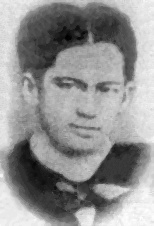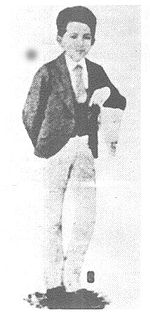SocSci6 >> Life, Writings and Works of Jose Rizal
Rizal's Alma Mater

Rizal as a student at the University of Santo Tomas.
Rizal first studied under Justiniano Aquino Cruz in Biñan, Laguna before he was sent to Manila. As to his father's request, he took the entrance examination in Colegio de San Juan de Letran and studied there for almost three months. The Dominican friars asked him to transfer to another school due to his radical and bold questions.[19] He then enrolled at the Ateneo Municipal de Manila and graduated as one of the nine students in his class declared sobresaliente or outstanding. He continued his education at the Ateneo Municipal de Manila to obtain a land surveyor and assessor's degree, and at the same time at theUniversity of Santo Tomas where he did take up a preparatory course in law.[20] Upon learning that his mother was going blind, he decided to study medicine specializing in ophthalmology at the University of Santo Tomas Faculty of Medicine and Surgery.
Rizal, 11 years old, a student at the Ateneo Municipal de Manila.
Without his parents' knowledge and consent, but secretly supported by his brother Paciano, he traveled alone to Madrid, Spain in May 1882 and

studied medicine at the Universidad Central de Madrid where he earned the degree, Licentiate in Medicine. His education continued at the University of Paris and the University of Heidelberg where he earned a second doctorate. In Berlin he was inducted as a member of the Berlin Ethnological Society and the Berlin Anthropological Society under the patronage of the famous pathologist Rudolf Virchow. Following custom, he delivered an address in German in April 1887 before the Anthropological Society on the orthogra
phy and structure of the Tagalog language. He leftHeidelberg a poem, "A las flores del Heidelberg," which was both an evocation and a prayer for the welfare of his native land and the unification of common values between East and West.
At Heidelberg, the 25-year-old Rizal, completed in 1887 his eye specialization under the renowned professor, Otto Becker. There he used the newly invented ophthalmoscope (invented by Hermann von Helmholtz) to later operate on his own mother's eye. From Heidelberg, Rizal wrote his parents: “I spend half of the day in the study of German and the other half, in the diseases of the eye. Twice a week, I go to the bierbrauerie, or beerhall, to speak German with my student friends.” He lived in a Karlstraße boarding house then moved to Ludwigsplatz. There, he met Reverend Karl Ullmer and stayed with them inWilhelmsfeld, where he wrote the last few chapters of "Noli Me Tangere".
A plaque marks the Heidelberg building where he trained with Professor Becker, while in Wilhemsfeld, a smaller version of theRizal Park with his bronze statue stands and the street where he lived was also renamed after him. A sandstone fountain in Pastor Ullmer’s house garden where Rizal lived in Wilhelmsfeld, stands.[21]
Rizal's multifacetedness was described by his German friend, Dr. Adolf Meyer, as "stupendous."[22][23] Documented studies show him to be a polymath with the ability to master various skills and subjects.[3][4][22] He was an ophthalmologist, sculptor, painter, educator, farmer,historian, playwright and journalist. Besides poetry and creative writing, he dabbled, with varying degrees of expertise, in architecture, cartography, economics,ethnology, anthropology, sociology, dramatics, martial arts, fencing and pistol shooting. He was also a Freemason, joining Acacia Lodge No. 9 during his time in Spain and becoming a Master Mason in 1884.
First Travel
In 1885, the 24-year old Rizal went to Paris, France to pursue his career as an ophthalmologist. He tried his skills in music and studied solfeggio, piano and voice culture for a month and a half. He worked as an assistant to the renowned ophthalmologist, Dr. Louis de Weckert, and left for Heidelberg after a year. He settled in the house of a Lutheran, Karl Ullmer and worked in the clinics of famous Polish and German ophthalmologists, Dr. Javier Galezowsky and Dr. Otto Becker, respectively. In Heidelberg, he was astound with the flowers along the Neckar River, especially the forget-me-nots, which made him compose the poem, A Las Flores de Heidelberg (To the Flowers of Heidelberg), on April 22, 1886. It was also in this German city where the long-distance friendship between Jose Rizal and Ferdinand Blumentritt began.
Rizal traveled to Leipzig and attended some lectures at its local university. After which he went to Berlin to further study ophthalmology and other languages, to get familiar with the scenic Germany, to be part of the scientific community, and to finish his novel, Noli Me Tangere. However, he was struck by financial problem in Berlin as he was short of allowance from Calamba.
Back to the Philippines
The stunning beauty of the European lands did not stop Rizal from continuously adoring his native land. After the Noli Me Tangere was published, he decided to return to Calamba despite the many warnings he received from friends and relatives alike. He had four reasons for returning to the Philippines:
- to perform an operation on Doña Teodora's eyes;
- to defend his oppressed countrymen more effectively than doing so in a foreign land;
- to find out how his Noli was received by the Filipinos and Spaniards; and
- to know the reason for Leonor Rivera's long silence.
Aboard the steamer Djemnah, Rizal sailed to the East via the Suez Canal on June 3, 1887 and reached Saigon on the 30th of July. From Saigon, he boarded the steamer Hayfong bound forManila. On the sixth day of August, he arrived in Manila and visited some friends, and reached Calamba two days later. In his native land, he opened a medical clinic and restored hismother's vision. Such “miraculous” news spread throughout the community like wild fire, thus, his clinic was flocked by people aspiring for a better eyesight. Newly arrived from Germany, he began to be known as “Doctor Uliman” (from the word Aleman).
Regarding his novel Noli Me Tangere, Rizal met Governor General Emilio Terrero who informed him of the charges against him. As a defense, Rizal told Terrero that the Noli only exposes the reality. Not having read the book yet and out of curiosity, the governor general asked for a copy of the controversial novel, which he later confessed that he enjoyed reading. He saw no problem on the book, yet to protect Rizal's life which was then in danger, he assigned Jose Taviel de Andrade, a young Spanish lieutenant, as Rizal's personal bodyguard. Soon enough, the attackers and defenders of the novel resurfaced.
Second Travel
Realizing that his family's and friends' safety were at risked; and that his fight against the Spaniards have better chance of winning if he'd stay abroad, Rizal, six months after, finally decided to sail back to Europe. Before his departure, a friend from Lipa City, Batangas asked of him a poem dedicated to the industrious workers in their town. Privileged, Rizal wrote the Himno Al Trabajo (Hymn to Labor).
A glance of East Asia
On February 3, 1888, for the second time, Rizal sailed to Hongkong as a frustrated being who wanted the utmost reform in his native land. Terrero’s former secretary, Jose Sainz de Varranda, followed Rizal in the said British colony, and was believed to be commissioned by the Spanish authorities to spy on the hero. After almost three weeks, on board the American steamer, Oceanic, he left Hongkong and sailed to Japan where he was invited by Secretary Juan Perez Caballero to live at the Spanish Legation. His instinct told him that it was a bait – a way for the Spanish officials to keep track of his activities. And since it was economical to stay at the legation and he believed that he had nothing to hide, he accepted it. Rizal was impressed by the scenic Japan and had keenly observed the life, customs and culture of the people. He had fallen in love not only with the view but more to its women, particularly with the 23-year old O-Sei-San (a.k.a. Usui Seiko).
Sail to the West
Rizal was almost tempted to settle in Japan with O-Sei-San, but on April 13, 1888, Rizal boarded the English steamer, Belgic bound for the United States, reaching the land on April 28. He visited San Francisco, left it on the second day for Oklahoma, then to Sacramento, then to Reno, and finally to New York. On May 16, 1888 the ship, City of Rome sailed for Liverpool and where he decided to stay in London until March 1899. Rizal chose to stay in London so that he could improve his English skills, study and do an annotation of Antonio Morga's Sucesos de las Islas Filipinas and because he believed that the said English city was a safe place for him to carry on the reforms he wanted for the Philippines. He stayed at Dr. Antonio Ma. Regidor's home and boarded at the Beckett family where he fell in love with Gertrude.
